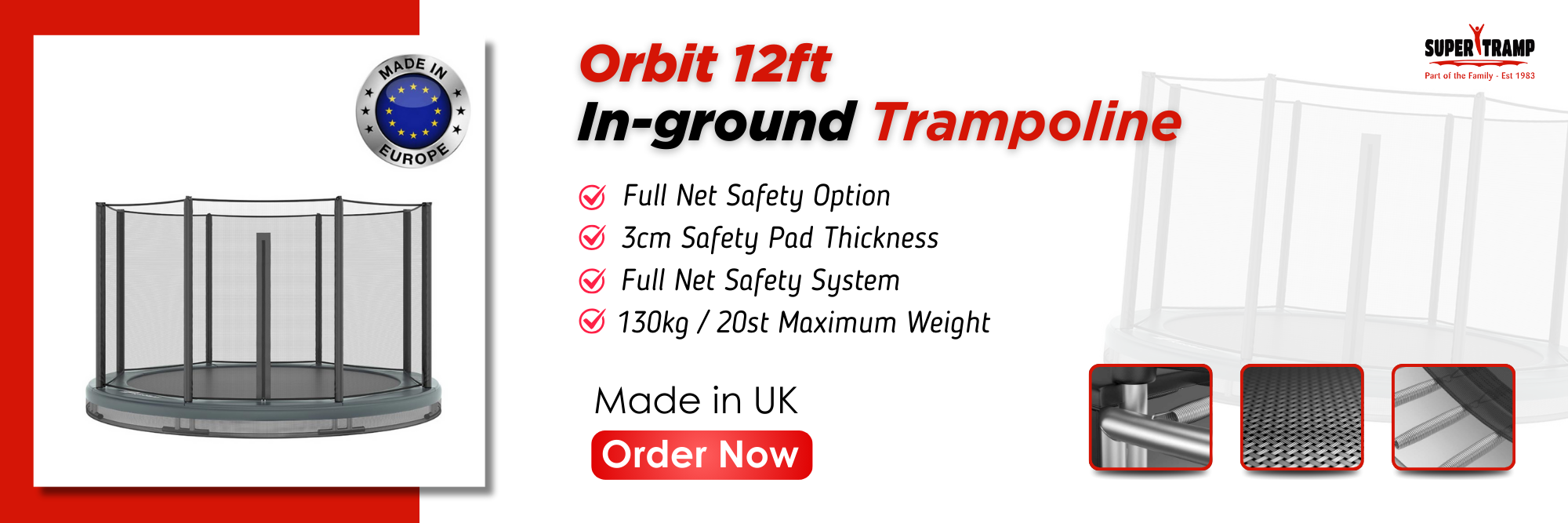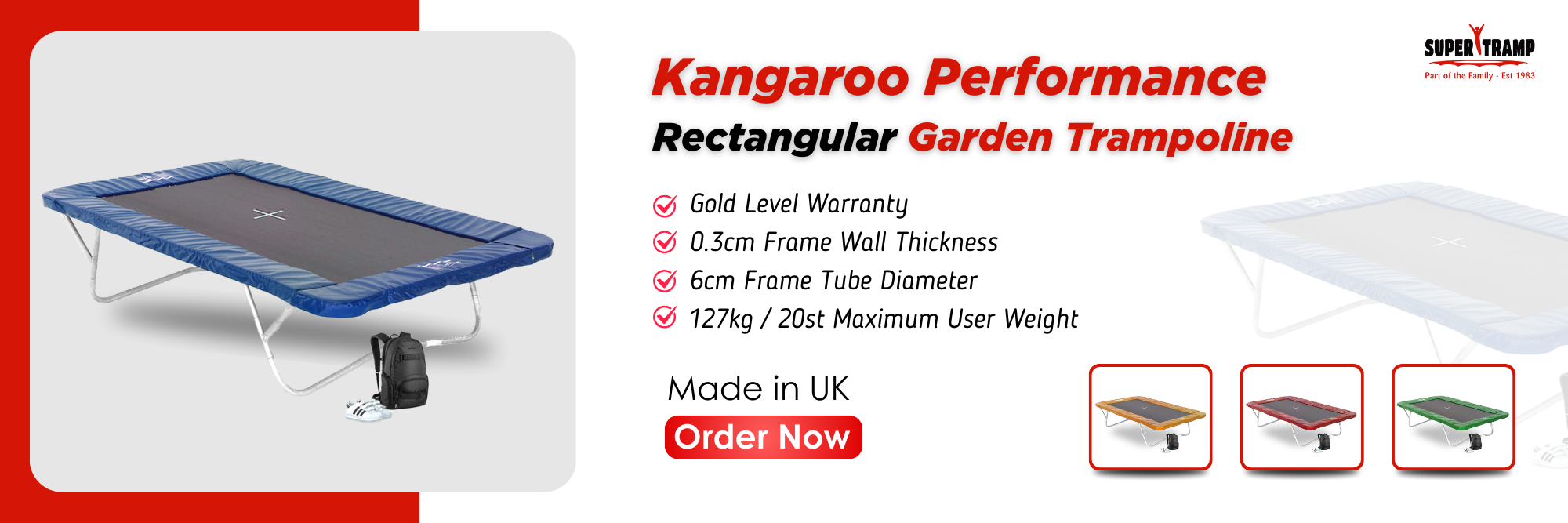Did you know why people prefer trampolines with more bounce? An ideal trampoline is one that is extremely bouncy, which not only makes every jump thrilling and enjoyable but also improves the whole experience. The right amount of bounciness is important for people who use trampolines for both amusement and training. Because there will be less strain on joints, the increased bounce can also make jumping safer and more enjoyable.
Table of Contents
ToggleThis blog will guide you through the operation of a trampoline and the factors that enhance its bounce. We will go over the elements that have a big impact on a trampoline’s bounce, the significance of selecting the correct trampoline size, and practical and efficient ways to increase your trampoline’s bounce. With hours of enjoyment and fitness guaranteed, together we’ll discover the keys to getting that ideal bounce.
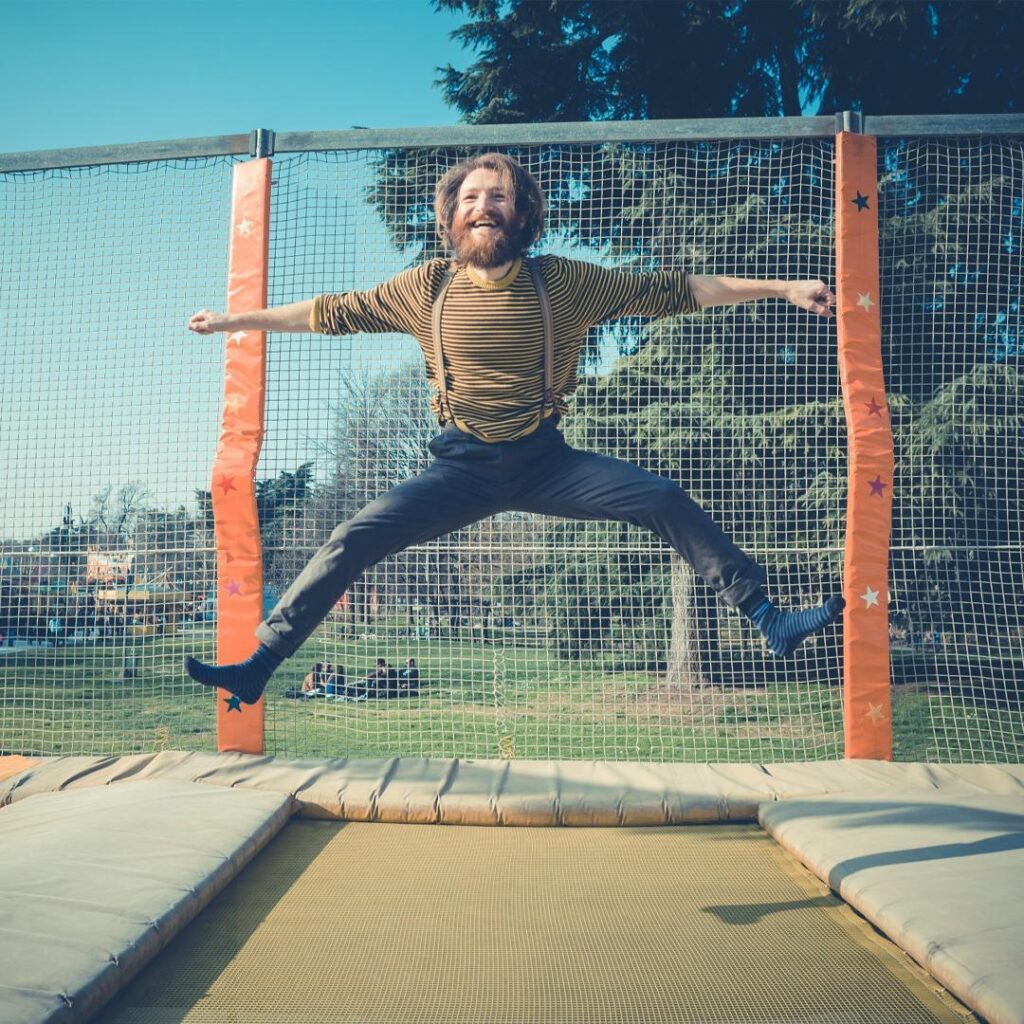
How Trampolines Create Perfect Bounce
Trampolines operate on a simple yet ingenious mechanism that transforms gravitational force into dynamic energy, propelling jumpers into the air with an exhilarating bounce. Understanding this mechanism not only enhances your appreciation for the device but also helps in optimising its performance.
Trampoline Mechanism

When a person jumps onto the in-ground trampoline, they compress the springs and stretch the mat downward. The springs store potential energy during this downward movement. As the jumper reaches the lowest point of their jump and starts moving upward, the stored energy in the springs is released, propelling the jumper upwards. This conversion of potential energy (stored in the springs) into kinetic energy (movement of the jumper) is what creates the bounce effect.
Importance of Good Bounce
The quality of bounce directly impacts the enjoyment and safety of trampoline use:
- Enhanced Fun: A trampoline with good bounce provides a thrilling experience, making jumps higher and more enjoyable.
- Exercise Efficiency: Better bounce allows for more dynamic movements, enhancing the effectiveness of exercise routines.
- Safety: Proper bounce distributes impact forces more evenly, reducing the risk of injury to joints and muscles.
Good bounce not only improves the enjoyment and fun but it also distributes the force more evenly, enhances the effectiveness of exercise routines and much more. But there are many components that can affect your quality of bounce. Let’s examine those components more deeply.
Components That Affect Bounce
Several factors influence the bounce quality of a trampoline:
- Spring Quality: High-quality, durable springs provide better elasticity and longevity, ensuring consistent bounce performance.
- Mat Tension: A tightly stretched mat enhances bounce responsiveness and longevity.
- Frame Stability: A sturdy frame minimises unnecessary movement and ensures an even distribution of bounce forces.
- Overall Design and Size: Larger trampolines generally offer better bounce due to increased surface area and longer springs.
Understanding these components and their roles is crucial for optimising your trampoline’s bounce and ensuring a safe and enjoyable experience for users of all ages.
Choosing the Right Size Trampoline

Choosing the right trampoline size is essential for optimising fun, guaranteeing security, and satisfying your unique requirements and available space. This can be a difficult decision to make because there are so many different kinds, sizes, and types of trampolines on the market, but knowing what to look for can help.
Types of Trampolines
- Garden Trampolines: These are the most common and come in various sizes, typically round or rectangular, designed for outdoor use.
- Professional Trampolines: Designed for gymnasts and athletes, these are larger and built to withstand more intense use.
- In-ground trampolines: They are installed at ground level, offering a sleek and safe alternative to traditional above-ground trampolines.
- Above-ground trampoline: Above-ground trampolines are popular for their ease of setup and portability, making them a convenient option for backyards. They typically come with safety nets and padding to reduce the risk of injury.
- Fitness trampoline: Fitness trampolines, also known as rebounders, are small, durable trampolines designed for indoor exercise routines. They provide a low-impact workout, helping to improve cardiovascular health, balance, and overall fitness.
- Performance trampoline: Performance trampolines are designed for athletes and gymnasts, offering superior bounce and durability to support advanced tricks and high-intensity training.
- Bespoke trampoline: Bespoke trampolines are custom-made to fit specific needs and preferences, offering unique sizes, shapes, and features tailored for individual users or specialised applications.
Every trampoline is designed to suit different garden types. The size and shape of your unique garden will determine the appropriate trampoline size you can accommodate.
Size and Shape
Round Trampolines: Round trampolines are the most popular for residential use. They are generally safer for younger children as the bounce directs the jumper towards the centre.
- Sizes: Typically range from 8 to 16 feet in diameter.
- Recommendation: 10ft Primus Flat Trampoline
Rectangular Trampolines: Preferred by gymnasts and serious jumpers due to the even bounce and larger jumping area.
- Sizes: Vary widely, but common sizes include 7×10 feet, 8×12 feet, and 9×14 feet.
- Recommendation: 10 X 6ft Primus flat rectangular trampoline
Square Trampolines: Offer a good compromise between round and rectangular trampolines, providing ample jumping space with a more uniform bounce.
- Sizes: Often available in 10×10 feet or 12×12 feet.
- Recommendation: Playground trampoline – Quad 150
Choosing the right size and type of trampoline tailored to your needs and space ensures maximum enjoyment, safety, and longevity of the equipment.
How You Can Make Your Trampoline Bouncier
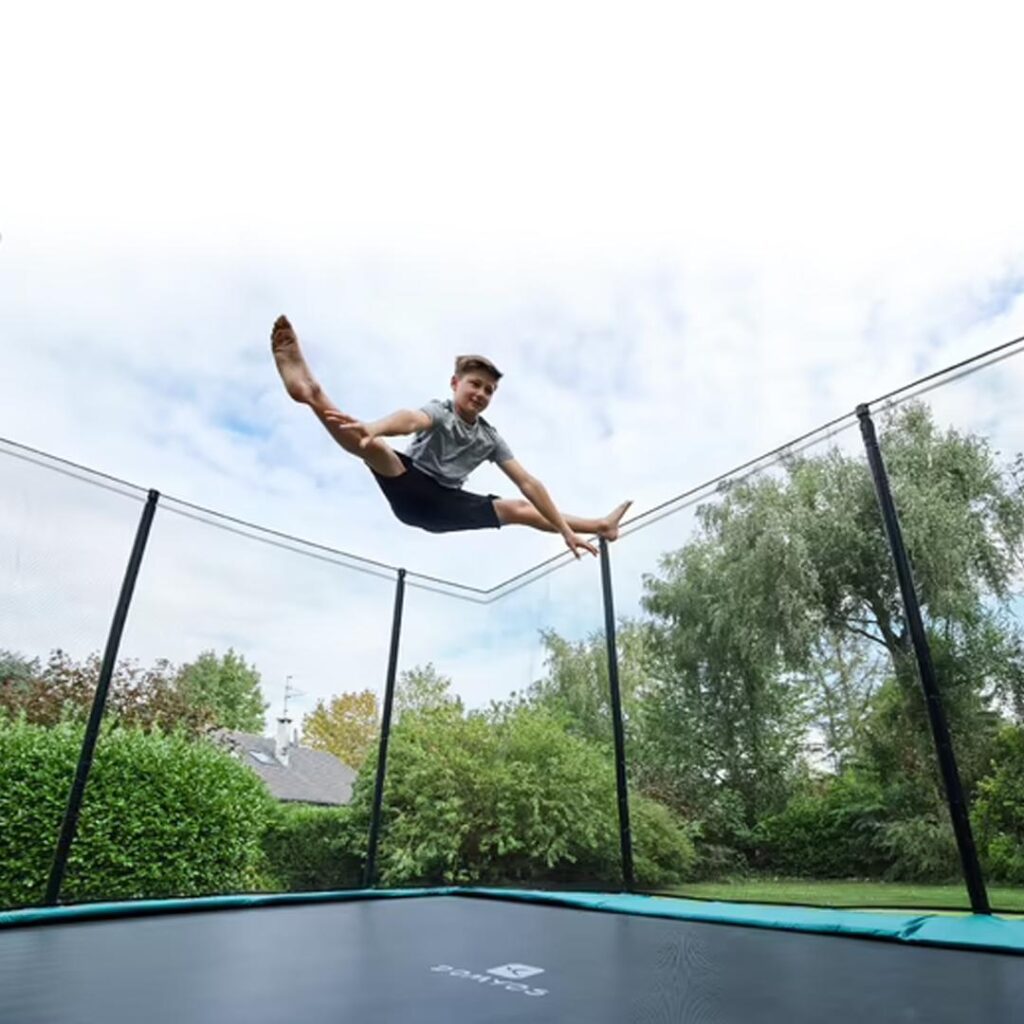
Achieving the perfect bounce on your trampoline involves a combination of regular maintenance, quality components, and attention to safety. Here are some steps you can follow to make your trampoline super bouncy:
1. Invest in High-Quality Trampoline Springs
The springs are the heart of your trampoline’s bounce. Upgrading to high-quality springs can significantly enhance bounce performance.
Types of Springs
- Galvanised Steel Springs: Durable and resistant to rust, ideal for outdoor trampolines.
- Zinc-plated springs: Offer high elasticity and are also resistant to corrosion.
Different Techniques of Assembling Springs
- Even Tension Assembly: Ensure that springs are evenly spaced and attached to distribute tension uniformly across the mat.
- Cross-Spring Pattern: Attach springs in a criss-cross pattern to balance the tension and provide a more consistent bounce.
The springs on your trampoline are crucial for producing the bounce therefore it is important to check for any wear and tear and replace the spring on time to ensure proper bounce of your trampoline.
2. Get a Better Elastic Trampoline Mat
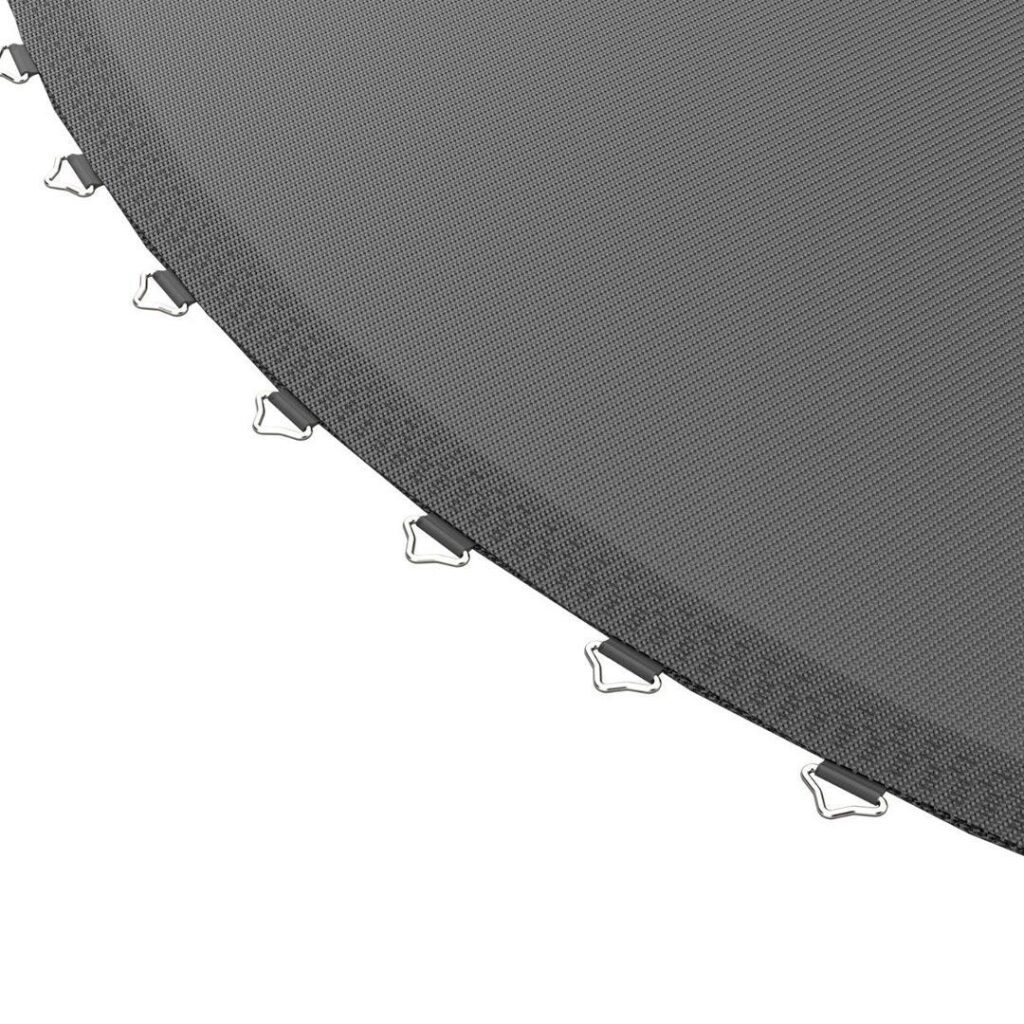
The trampoline mat plays a crucial role in the bounce quality. Purchasing higher-quality mat might have a big impact.
Types of Trampoline Mats
- Polypropylene Mats: Known for their durability and excellent bounce.
- Permatron Mats: Offer superior performance and weather resistance.
Importance of a Better Trampoline Mat
- A high-quality trampoline mat offers superior elasticity and responsiveness, resulting in a more powerful and enjoyable bounce.
- Better mats are made from durable materials that resist wear and tear, ensuring the trampoline lasts longer and maintains performance over time.
- High-quality mats reduce the risk of tears and holes, which can prevent accidents and injuries caused by falling through or tripping on damaged areas.
- Superior trampoline mats are designed to withstand various weather conditions, including UV rays, rain, and snow, without degrading, making them ideal for outdoor use.
3. Enhancing Your Trampoline Frame
A strong and stable frame is essential for a good bounce. You can ensure a long lifespan of frames by covering the frame with frame pads which help to shield it from exposure to weather elements like rain, snow, and UV rays and protecting users from injuries caused by accidental falls or collisions with the frame.
Types of Frames
- Steel Frames: Common and durable, ideal for most trampolines.
- Aluminium Frames: Lightweight but strong, suitable for portable trampolines.
Importance of a Strong Frame
- A strong frame provides the essential support needed to maintain the overall structure of the trampoline, ensuring it remains stable and secure during use.
- A sturdy frame minimises the risk of the trampoline collapsing or bending, which can prevent serious injuries to users.
- A robust frame ensures that the energy from each jump is effectively transferred to the springs and mat, resulting in a better and more consistent bounce.
- High-quality frames are made from durable materials that can withstand regular use and harsh weather conditions, extending the lifespan of the trampoline.
4. Proper Airflow Matters

Proper airflow underneath the trampoline is crucial for optimal bounce. Trampolines with good airflow allow the mat to move more freely.
How It Will Make Trampoline More Bouncy
- Improved airflow reduces resistance under the mat, allowing it to stretch and rebound more effectively, thus enhancing the bounce.
- Good airflow helps balance the pressure underneath the mat, preventing it from becoming too stiff and ensuring a consistent and smooth bounce across the entire surface.
- When air can flow freely, the springs can work more effectively in unison with the mat, maximising the energy transfer and resulting in a higher and more powerful bounce.
5. Inspect and Maintain Your Trampoline
Regularly inspecting your trampoline ensures that all components are in good condition and functioning properly. Check for any signs of wear and tear, such as rusted springs, tears in the mat, or loose bolts. Keeping your trampoline well-maintained prevents minor issues from becoming major problems that can affect bounce quality.
6. Required Maintenance Checks for Your Trampoline
After inspection, promptly address any issues found. Replace worn-out springs, fix or replace damaged mats, and tighten any loose bolts. Ensuring that each component is in optimal condition is essential for maintaining the best bounce.
7. Prioritise Safety on Your Trampoline
Ensuring safety on trampolines is paramount, as it not only protects users from potential injuries but also enhances the overall enjoyment and longevity of the equipment.
Importance of Safety
- Ensuring safety measures are in place protects users, especially children, from accidents.
- Knowing that safety measures are in place allows parents to feel more comfortable letting their children play on the trampoline.
- Implementing and teaching safety protocols encourages users, especially children, to adopt safe practices when jumping, which can be beneficial in other aspects of their physical activities.
- Ensuring that your trampoline is safe can protect you from potential legal issues or liability claims if someone is injured while using it.
Safety Accessories
- Safety enclosure: Prevent jumpers from falling off the trampoline.
- Spring Covers: Protect users from getting pinched by the springs.
- Padding: Cushions the frame and springs, reducing the risk of injury.
- Weather covers: Protect the trampoline for changing weather conditions like heavy rainfall, snowfall etc.
By following these steps and incorporating high-quality components, you can significantly improve your trampoline’s bounce, ensuring a safer and more enjoyable jumping experience for everyone.
Conclusion
With the essentials of trampoline optimization under your belt, you’re ready to create a safe and exhilarating jumping experience! From understanding how a trampoline works to selecting the right size and type, each step plays an important role in enhancing both performance and safety. Practical tips like regular maintenance, upgrading to quality springs and mats, and ensuring a sturdy frame and proper airflow all contribute to a bouncier, safer experience.
Implementing these tips requires attention to detail and a commitment to safety. By following these guidelines, you’ll not only boost your trampoline’s bounce but also ensure countless hours of fun for everyone involved.
What’s your experience with trampoline maintenance and enhancement? Share your tips and thoughts in the comment section—we’re excited to hear from you! Happy jumping!
To bounce super high on a trampoline, focus on timing and technique. Use your legs to generate power as you jump, aiming to land in the centre of the mat to maximise the rebound effect. Maintain a straight posture and synchronise your movements with the trampoline’s bounce for optimal height.
If your trampoline isn’t very bouncy, several factors could be at play. Check for worn-out springs or a sagging mat, as these can significantly impact bounce quality. Ensure the trampoline is properly assembled and positioned on a flat surface, and consider upgrading to higher-quality springs and a more elastic mat for better bounce performance.
To make a trampoline more fun, consider adding activities like playing games such as trampoline basketball or tag. You can also incorporate flips or tricks. Adding accessories like a bounce board or water sprinkler attachment can also enhance the enjoyment of jumping sessions.
Yes, trampolines can become more bouncy over time as the springs and mat stretch and settle. Regular inspections and maintenance are key to ensuring safe and consistent bounce performance throughout the trampoline’s lifespan.
Yes, generally, bigger trampolines tend to bounce higher because they have larger mats and longer springs, which can generate more lift and provide a greater rebound effect compared to smaller trampolines.
DON'T MISS...
- Why Somersault System Are Best for Trampoline Parks
- Inspiring Contemporary Garden Design Ideas to Refresh Your Backyard
- Reach New Heights: Discover The Best Trampolines for Higher Jumps
- 7 Tips for Selecting Safety Enclosure Spares For Trampoline!
- Why Resistance Band Good for Full-body Strength Workout?



